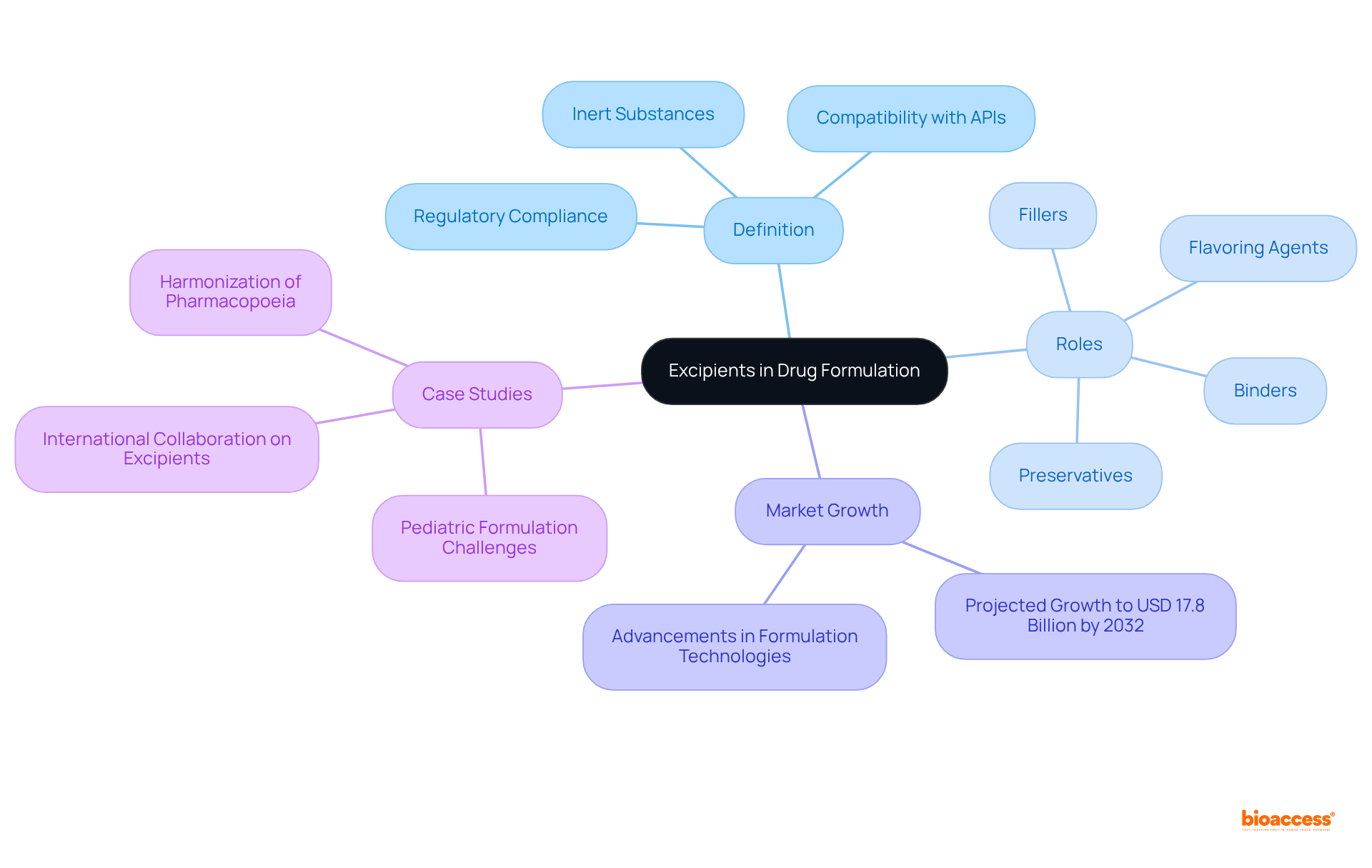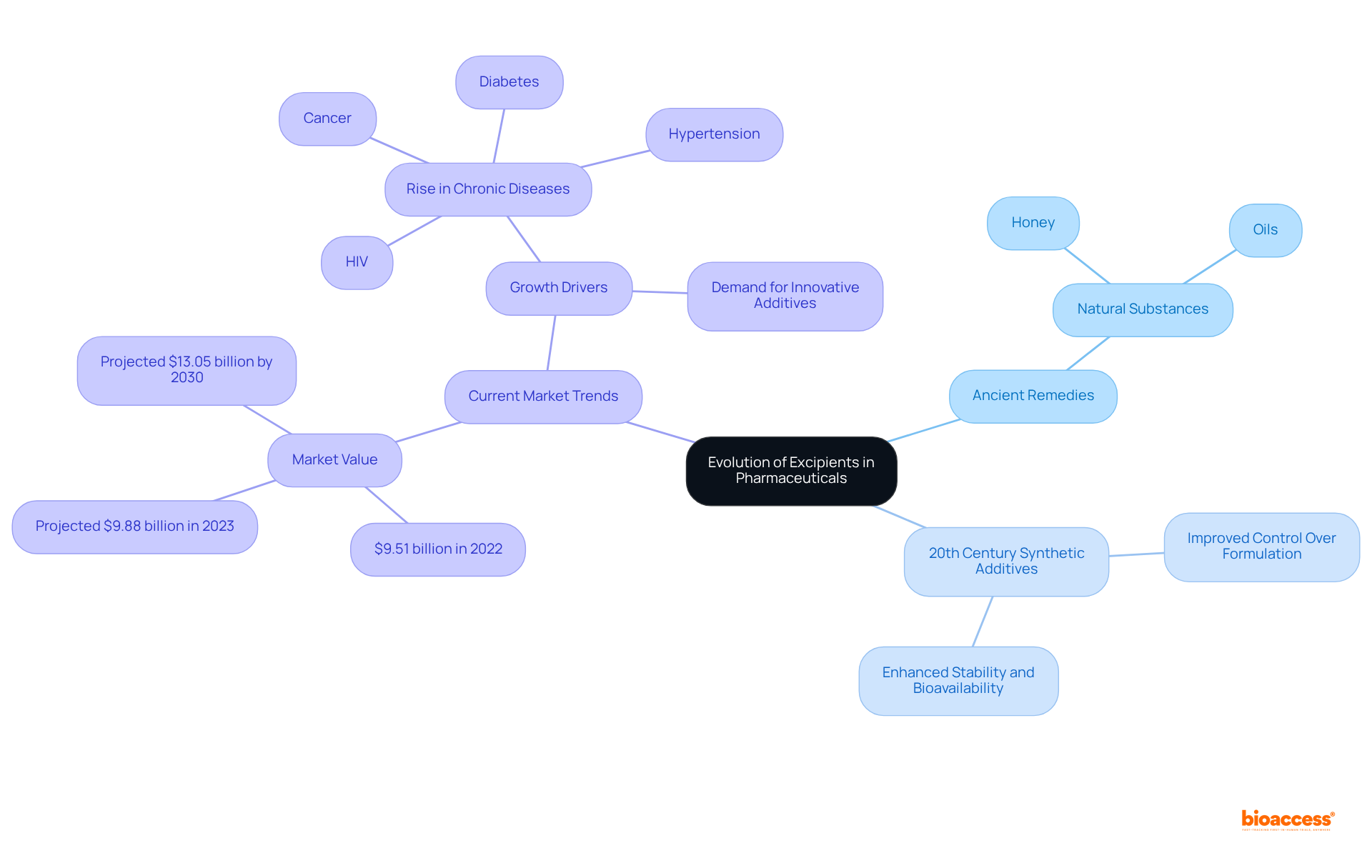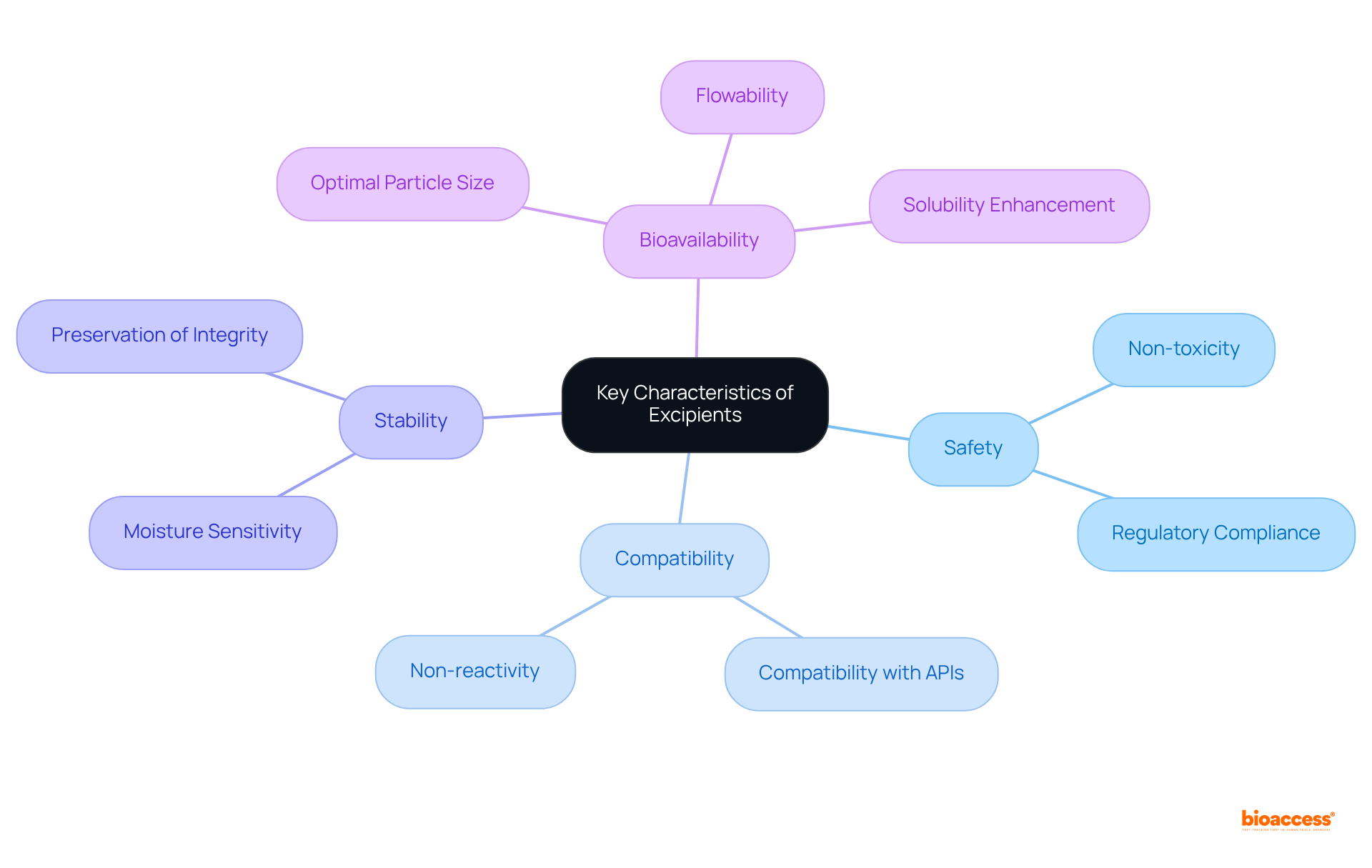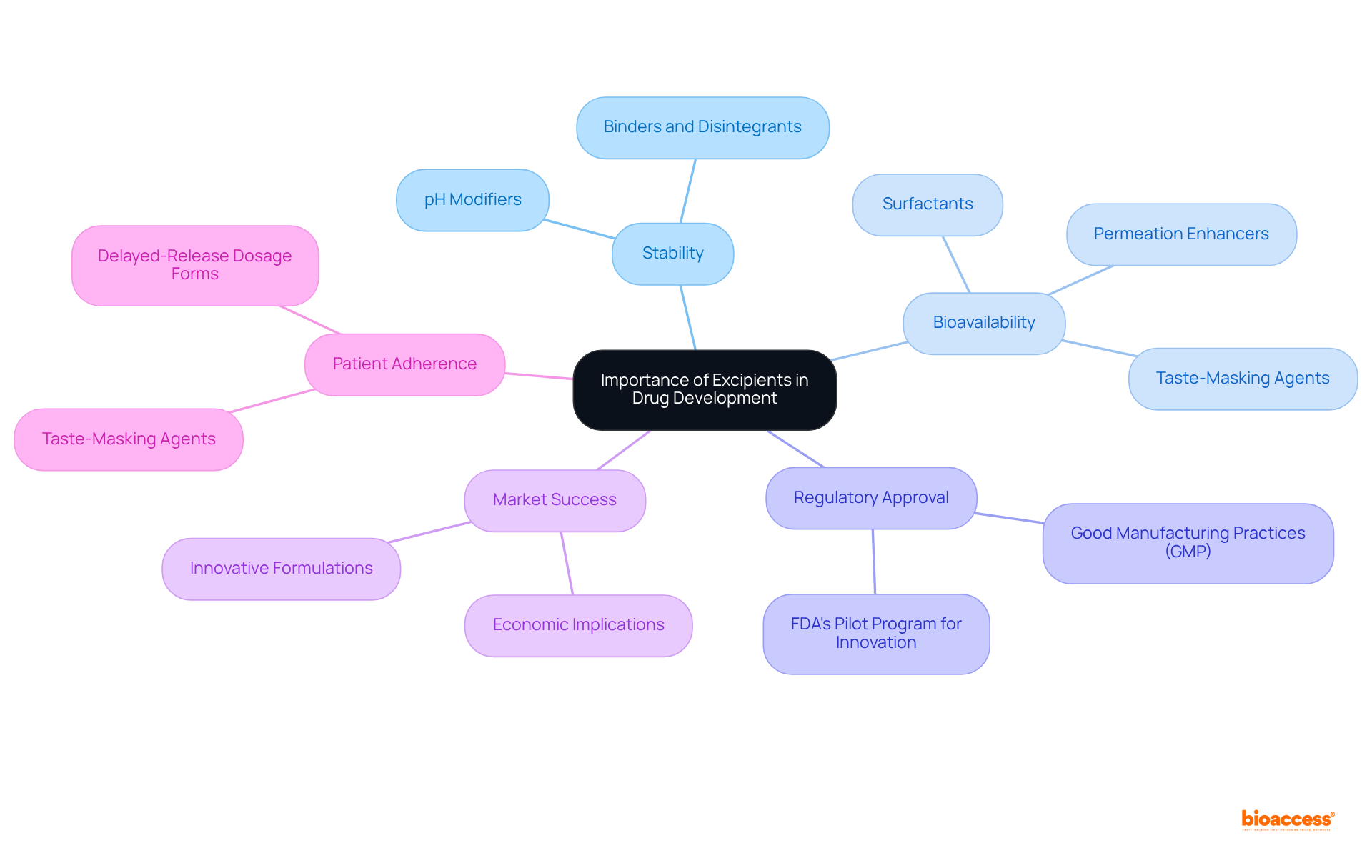


Excipients are inert substances that play a critical role in drug formulation, enhancing the stability, bioavailability, and overall effectiveness of active pharmaceutical ingredients (APIs). Their various functions, such as acting as binders and preservatives, are essential in the development of effective medications.
It is crucial to select compatible excipients that meet rigorous safety standards, as this ensures both medication efficacy and patient acceptability.
The significance of excipients in clinical research cannot be overstated, as they directly influence the therapeutic outcomes of pharmaceutical products.
The intricate world of pharmaceuticals extends beyond active ingredients, as excipients play a pivotal role in formulating effective medications. These inert substances not only enhance the stability and bioavailability of active pharmaceutical ingredients (APIs) but also ensure that medications remain safe and acceptable for patients. With the market for these additives continuing to grow, understanding their functions and characteristics becomes increasingly vital.
What challenges arise in the selection and application of excipients?
How do they influence the overall success of drug development?
The excipients definition describes inert substances that are integrated into medication mixtures, playing critical roles in the production process and enhancing the stability and bioavailability of active ingredients (APIs). They fulfill various functions—acting as binders, fillers, preservatives, and flavoring agents—which collectively contribute to the medication's effectiveness, safety, and acceptability among patients. The selection of these additives is paramount; according to the excipients definition, they must demonstrate compatibility with the API and comply with rigorous regulatory standards for safety and efficacy.
In 2025, the importance of additives in pharmaceuticals is underscored by their projected market growth, anticipated to reach USD 17.8 billion by 2032, driven by advancements in formulation technologies. This expansion highlights the increasing recognition of the significant impact that inactive ingredients have on formulation stability and bioavailability, as outlined in the excipients definition, ensuring that medications maintain their integrity over time and deliver therapeutic effects efficiently. For example, multifunctional additives improve flowability and compressibility, thereby streamlining the manufacturing process while enhancing the bioavailability of APIs.
Case studies illustrate the pivotal role of additives in medication formulations. In pediatric preparations, the meticulous selection of additives is essential due to the unique physiological differences observed in children. Research underscores the need for a clearer excipients definition and quantitative data regarding additives to ensure their safe application in vulnerable populations. Moreover, the development of specialized substances has been shown to enhance the stability and sustained release of APIs, addressing formulation challenges and improving patient outcomes. As the field of drug development evolves, the role of additives will remain fundamental in ensuring the effectiveness and safety of therapeutic interventions.

The history of additives in medicines dates back to ancient remedies, where natural substances such as honey and oils were utilized to enhance the delivery of active components. As pharmaceutical science progressed, the excipients definition evolved considerably, highlighting the increasing complexity and functionality of inactive ingredients. The 20th century marked a pivotal transformation with the advent of synthetic additives, enabling improved control over formulation processes, which in turn led to enhanced stability and bioavailability. Today, the excipients definition recognizes additives as essential elements rather than mere inactive fillers; they play a crucial role in influencing the pharmacokinetics and pharmacodynamics of medications.
The global additives market was valued at approximately $9.51 billion in 2022 and is projected to reach $9.88 billion in 2023, reflecting a compound annual growth rate (CAGR) of 4.03% from 2023 to 2030. This growth underscores the increasing demand for innovative additives, driven by the rise in chronic illnesses and the need for sophisticated medication formulations. This evolution underscores the importance of additives in enhancing medication effectiveness and patient adherence, representing a significant advancement in medication development.

The excipients definition illustrates their crucial role in formulation, characterized by their safety, compatibility with active pharmaceutical ingredients (APIs), and ability to enhance stability and bioavailability. Essential characteristics of inactive ingredients include non-toxicity, non-reactivity, and purity, which are critical for maintaining drug efficacy.
Furthermore, additives must demonstrate favorable physical characteristics such as optimal particle size, flowability, and moisture content to enable consistent manufacturing processes. For instance, lubricants like magnesium stearate are commonly employed to enhance powder flow during tablet compression, while stabilizers such as silica gel are essential for preserving the integrity of moisture-sensitive formulations.
In 2023, the demand for additives that ensure safety and compatibility has surged, with the fillers and diluents segment accounting for the highest revenue share in the market. The global pharmaceutical additives market was valued at around 8 billion U.S. dollars, reflecting the industry's focus on developing high-quality pharmaceuticals.
Moreover, the FDA's endorsement of 59 innovative medications in 2023 highlights the importance of additives in new medication development. As the market evolves, adherence to stringent safety standards for additives remains paramount, ensuring that they meet regulatory requirements and contribute positively to therapeutic outcomes.

The excipients definition is fundamental to medication development, as they influence not only the stability and bioavailability of formulations but also their regulatory approval and market success. The careful selection of additives can significantly impact the release characteristics of medications, patient adherence, and overall therapeutic efficacy. For example, taste-masking agents in pediatric formulations can greatly improve patient compliance with medication regimens. Moreover, as regulatory agencies intensify their scrutiny of excipient safety and functionality, understanding the excipients definition becomes crucial for the successful selection of high-quality excipients in drug development and commercialization.

The exploration of excipients reveals their indispensable role in drug formulation, serving as the backbone that enhances the stability, bioavailability, and overall efficacy of medications. Understanding the definition of excipients is crucial, as these inert substances are not merely fillers but vital components that ensure the safety and effectiveness of active pharmaceutical ingredients (APIs). Their significance extends beyond manufacturing, impacting patient compliance and therapeutic outcomes.
Key insights throughout the article highlight the multifaceted functions of excipients, including their historical evolution from ancient remedies to modern synthetic additives. The importance of selecting compatible and high-quality excipients is underscored, with market trends indicating a growing demand for innovative additives that cater to the complexities of contemporary drug development. Additionally, the discussion emphasizes the regulatory landscape that governs excipient usage, ensuring safety and efficacy in pharmaceutical products.
Ultimately, the significance of excipients in drug formulation cannot be overstated. As the pharmaceutical industry continues to evolve, a deeper understanding of excipients will be vital for researchers, manufacturers, and regulatory bodies alike. Embracing the complexities of excipients will lead to improved medication formulations, fostering better health outcomes and enhancing patient adherence. The call to action is clear: prioritize the study and application of excipients to unlock their full potential in the realm of pharmaceuticals.
What are excipients in drug formulation?
Excipients are inert substances integrated into medication mixtures that play critical roles in the production process and enhance the stability and bioavailability of active ingredients (APIs).
What functions do excipients serve in medications?
Excipients serve various functions, including acting as binders, fillers, preservatives, and flavoring agents, which contribute to the medication's effectiveness, safety, and patient acceptability.
Why is the selection of excipients important?
The selection of excipients is crucial because they must demonstrate compatibility with the API and comply with rigorous regulatory standards for safety and efficacy.
What is the projected market growth for excipients by 2032?
The market for excipients is projected to reach USD 17.8 billion by 2032, driven by advancements in formulation technologies.
How do multifunctional additives impact drug formulation?
Multifunctional additives improve flowability and compressibility, streamlining the manufacturing process while enhancing the bioavailability of APIs.
Why is the selection of additives critical in pediatric preparations?
The selection of additives is essential in pediatric preparations due to the unique physiological differences in children, necessitating careful consideration to ensure safety.
What challenges do specialized substances address in drug formulation?
Specialized substances enhance the stability and sustained release of APIs, addressing formulation challenges and improving patient outcomes.
What is the significance of excipients in the evolving field of drug development?
As drug development evolves, the role of excipients remains fundamental in ensuring the effectiveness and safety of therapeutic interventions.